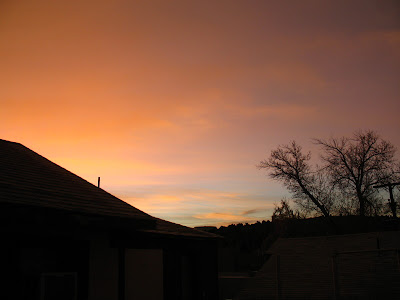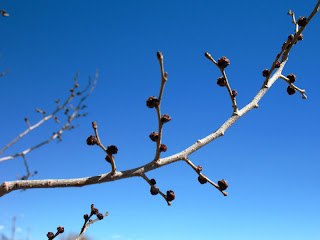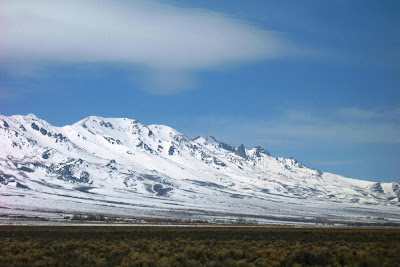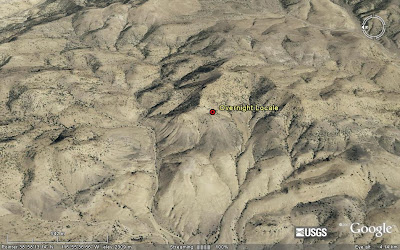 These photos were taken on Highway 50 near Austin Summit (elev 7484'), just uphill from last week's Austin Summit roadcut photos (also between Milepost 27 and Milepost 28). This reddish to reddish orange ash-flow tuff may underlie the tuffs seen earlier. This tuff shows columnar jointing, and the flattened pumice are more difficult to see than the reddish tuff in the previous post. This ash-flow tuff - unlike my "guess" of last week - is 30.8 Ma, according to Stewart and McKee (1977). The granitic rock the tuff is lying on (the light gray rock on the left of the photo) is a Jurassic quartz monzonite, 157 Ma, which hosts the silver veins of the Austin or Reese River mining district. Here's a more detailed geologic map of the Austin Summit area, from the Lander County Report, showing the ash-flow tuff as "Twt."
These photos were taken on Highway 50 near Austin Summit (elev 7484'), just uphill from last week's Austin Summit roadcut photos (also between Milepost 27 and Milepost 28). This reddish to reddish orange ash-flow tuff may underlie the tuffs seen earlier. This tuff shows columnar jointing, and the flattened pumice are more difficult to see than the reddish tuff in the previous post. This ash-flow tuff - unlike my "guess" of last week - is 30.8 Ma, according to Stewart and McKee (1977). The granitic rock the tuff is lying on (the light gray rock on the left of the photo) is a Jurassic quartz monzonite, 157 Ma, which hosts the silver veins of the Austin or Reese River mining district. Here's a more detailed geologic map of the Austin Summit area, from the Lander County Report, showing the ash-flow tuff as "Twt."
 Judging by scattered references I could find or access on the web, this ash-flow tuff may correlate with the 31.4 Ma Windous Butte Formation, which erupted from the Williams Ridge Caldera near Hot Creek Canyon and Morey Peak, Nevada. Some of the calderas erupting the large-volume ash-flow tuffs of Nevada are truly huge, as can be seen in the last link and in this one, where the debatable subject is whether the ignimbrite flare-up had anything to do with regional extreme extension in Nevada.
References:
Judging by scattered references I could find or access on the web, this ash-flow tuff may correlate with the 31.4 Ma Windous Butte Formation, which erupted from the Williams Ridge Caldera near Hot Creek Canyon and Morey Peak, Nevada. Some of the calderas erupting the large-volume ash-flow tuffs of Nevada are truly huge, as can be seen in the last link and in this one, where the debatable subject is whether the ignimbrite flare-up had anything to do with regional extreme extension in Nevada.
References:
NBMG Report 40 - Sediment-Hosted Precious-Metal Deposits of Northern Nevada - Road log/trip guide for SEG precious metals field trip, fall 1984, by J. V. Tingley, H. F. Bonham, Jr.
Geology & Ore Deposits of the Great Basin Symposium, Field Trip #2 Guidebook, Skarn Deposits in Nevada - Geology, Geochemistry, Mineralogy, and Petrology of Au, Cu, W, and An Skarns, leader L. D. Meniert, G. L. Myers, and J. W. Brooks, 1990. NBNG Bulletin 88 - Geology and mineral deposits of Lander County, Nevada; Part I, Geology, by John H. Stewart and Edwin H. McKee, Part II, Mineral deposits, by Harold K. Stager, 1977.
UPDATED 10July 2010













 These photos are from just east of Austin Summit, Nevada, just barely on the eastern, downhill side of the summit, between Milepost 27 and Milepost 28. Two exposures, this being the second on the way downhill, show welded ash-flow tuff. In this exposure, the red-gray to reddish gray ash-flow tuff is lying on a whitish unit of poorly welded tuff, air-fall tuff, or base surge tuff. The white unit lies on a gray, blocky-weathering ash-flow tuff, which can be seen to the left in the stitched photo. The compaction foliation and jointing in the red-gray and reddish ash-flow tuff to the right is roughly parallel to jointing or foliation in the tuff on the left, and roughly parallel to the contact.
These photos are from just east of Austin Summit, Nevada, just barely on the eastern, downhill side of the summit, between Milepost 27 and Milepost 28. Two exposures, this being the second on the way downhill, show welded ash-flow tuff. In this exposure, the red-gray to reddish gray ash-flow tuff is lying on a whitish unit of poorly welded tuff, air-fall tuff, or base surge tuff. The white unit lies on a gray, blocky-weathering ash-flow tuff, which can be seen to the left in the stitched photo. The compaction foliation and jointing in the red-gray and reddish ash-flow tuff to the right is roughly parallel to jointing or foliation in the tuff on the left, and roughly parallel to the contact.






























